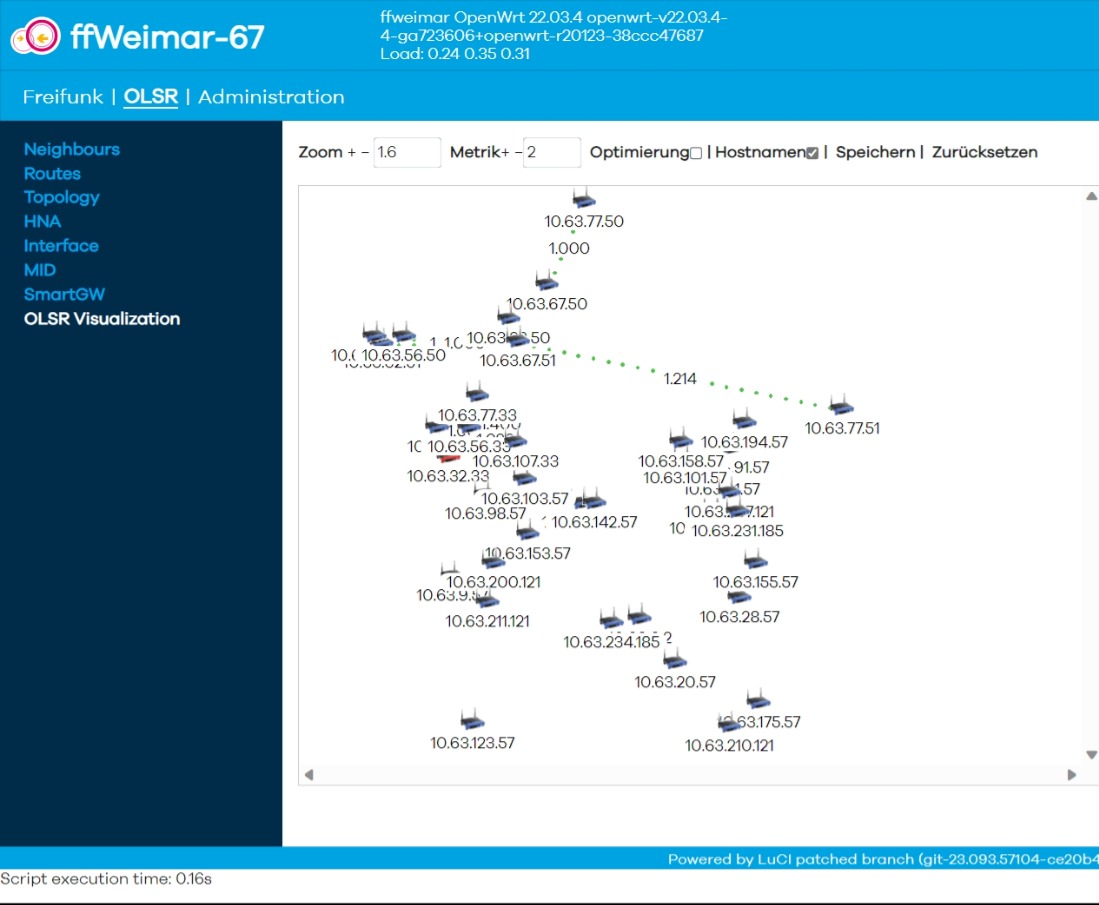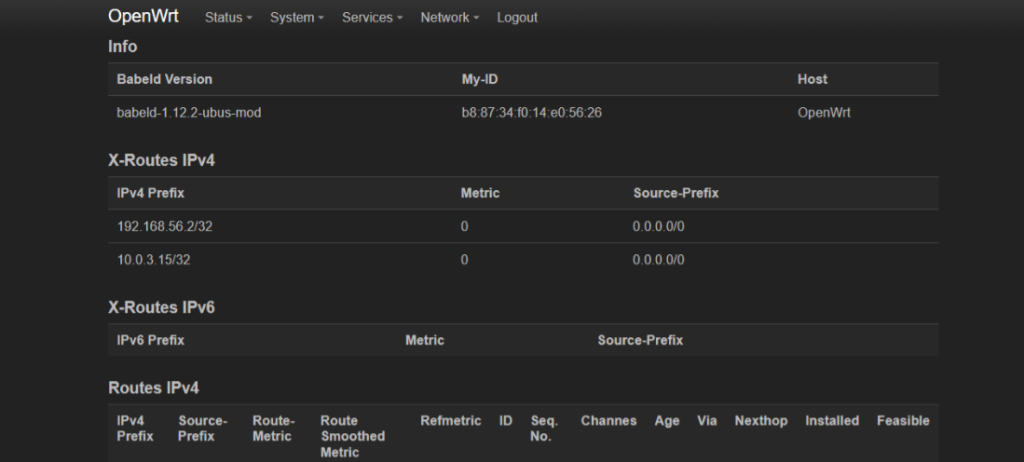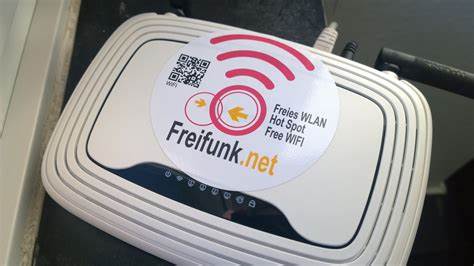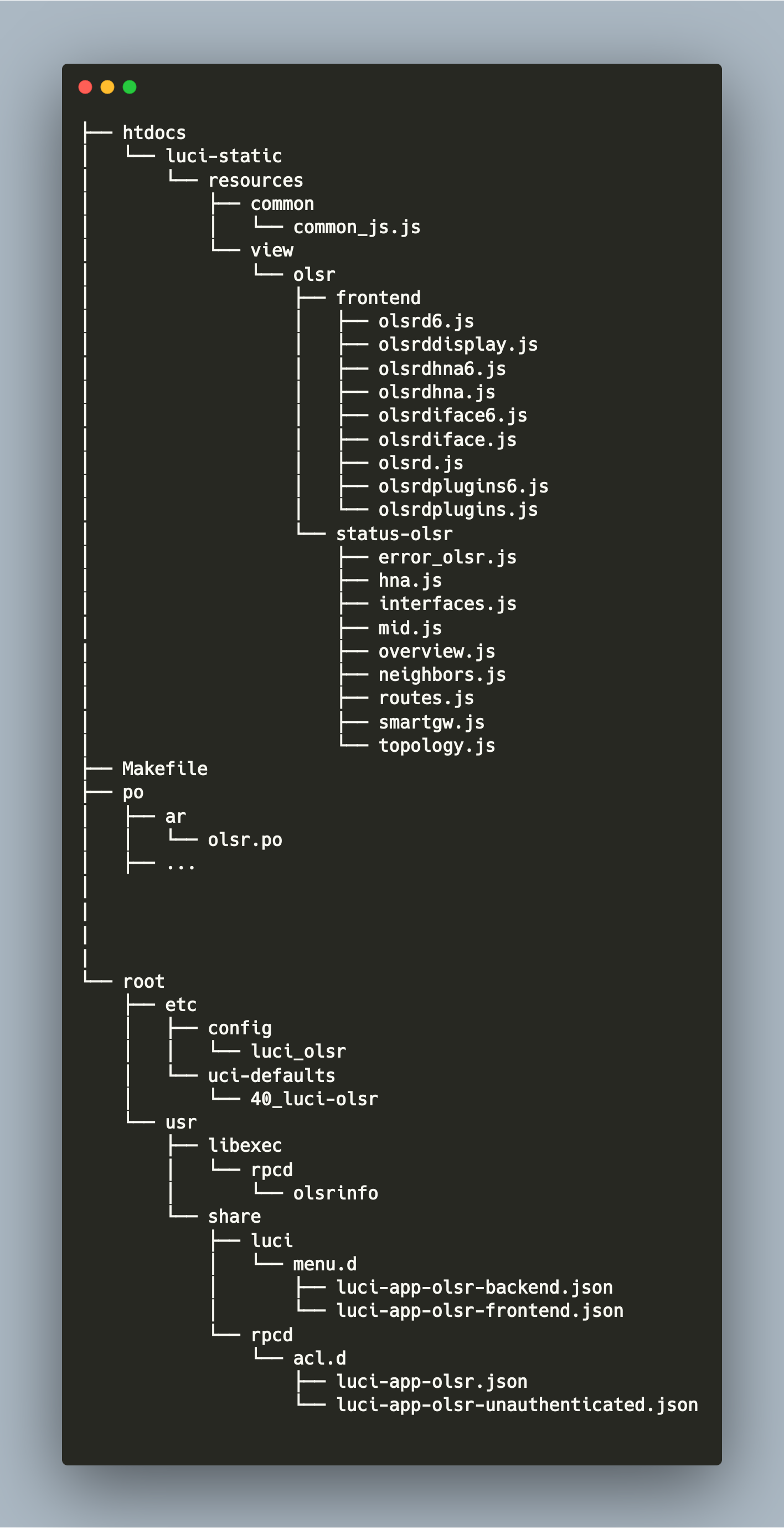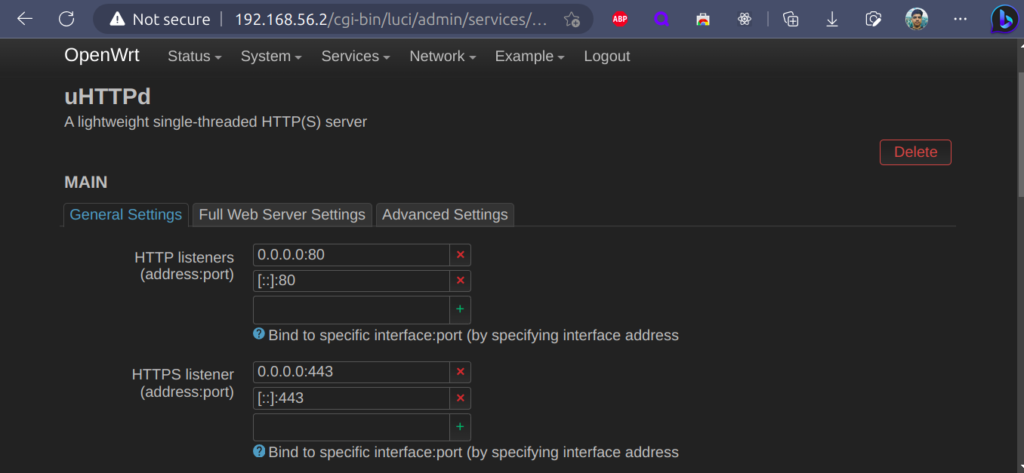The latest OpenWRT versions introduced a new web interface system that eliminated the need for Lua. Instead, the client’s browser handles the rendering and computation, allowing routers to focus on their primary tasks. This change has the advantage of eliminating the lua runtime, saving storage space, and having faster routers. In the previous CBI-based system, pages were rendered on the router and sent as HTML to the browser, increasing the load on the routers. This inefficiency can result in performance problems. To aid in this transition, LuCI offers the LuCI-JavaScript API, which is now utilized for constructing web interfaces.
luci-app-mjpg-streamer
I have successfully migrated luci-app-mjpg-streamer to JavaScript, making it a valuable example for building or migrating LuCI apps. This tutorial covers the essential aspects of the process, providing a comprehensive guide.
Below is the tree view representation of the directory structure for the app:
.
├── Makefile
├── htdocs
│ └── luci-static
│ └── resources
│ └── view
│ └── mjpg-streamer
│ └── mjpg-streamer.js
├── po
│ ├── ar
│ │ └── mjpg-streamer.po
│ ├── ...
│
│
│
└── root
└── usr
└── share
├── luci
│ └── menu.d
│ └── luci-app-mjpg-streamer.json
└── rpcd
└── acl.d
└── luci-app-mjpg-streamer.json
How to migrate your app :
ACLs
In the file root/usr/share/rpcd/acl.d/luci-app-mjpg-streamer.json, we provide all the necessary access permissions for our application to function properly.
{
"luci-app-mjpg-streamer": {
"description": "Grant UCI access for luci-app-mjpg-streamer",
"read": {
"uci": [
"mjpg-streamer"
]
},
"write": {
"uci": [
"mjpg-streamer"
]
}
}
}
For example, in my previously migrated app: luci-app-olsr, when there is a need to grant public access to specific pages, we ensure that all essential access permissions are appropriately configured in root/usr/share/rpcd/acl.d/luci-app-olsr-unauthenticated.json.
These permissions are necessary for the operation of our application when a user is not yet authenticated-
{
"unauthenticated": {
"description": "Grant read access",
"read": {
"ubus": {
"uci": ["get"],
"luci-rpc": ["*"],
"network.interface": ["dump"],
"network": ["get_proto_handlers"],
"olsrd": ["olsrd_jsoninfo"],
"olsrd6": ["olsrd_jsoninfo"],
"olsrinfo": ["getjsondata", "hasipip", "hosts"],
"file": ["read"],
"iwinfo": ["assoclist"]
},
"uci": ["luci_olsr", "olsrd", "olsrd6", "network", "network.interface"]
}
}
}
To learn more about how ACL (Access Control List) works, you can refer to this resource: OpenWRT’s docs It is important to consider applying the principle of least privilege when configuring ACLs.
MENU
In the file root/usr/share/luci/menu.d/luci-app-mjpg-streamer.json, we define the location where our view will be displayed in the admin menu. This is utilized for admin specific views
{
"admin/services/mjpg-streamer": {
"title": "MJPG-streamer",
"action": {
"type": "view",
"path": "mjpg-streamer/mjpg-streamer"
},
"depends": {
"acl": [
"luci-app-mjpg-streamer"
],
"uci": {
"mjpg-streamer": true
}
}
}
}
The path indicates the location where the JavaScript view to be rendered is present with respect to the htdocs/luci-static/resources/view directory.
FORMS
To explore the JavaScript APIs offered by LuCI, you can visit the following link: LuCI client side API documentation. A recommended starting point is the core luci.js class.
LuCI forms allow you to create UCI or JSON-backed configuration forms. To create a typical form, you start by creating an instance of either LuCI.form.Map or LuCI.form.JSONMap using new. Then, you can add sections and options to the form instance. Finally, invoking the render() method on the instance generates the HTML markup and inserts it into the Document Object Model(DOM). For a better understanding of how LuCI forms work, you can refer to the following : LuCI.form.
This is an example demonstrating the usage of LuCI.form within one of the admin’s views, using a small portion of the mjpg-streamer.js code. The full code for the file can be found here.
'use strict';
'require view';
'require form';
'require uci';
'require ui';
'require poll';
/* Copyright 2014 Roger D < rogerdammit@gmail.com>
Licensed to the public under the Apache License 2.0. */
return view.extend({
load: function () {
var self = this;
poll.add(function () {
self.render();
}, 5);
document
.querySelector('head')
.appendChild(
E('style', { type: 'text/css' }, [
'.img-preview {display: inline-block !important;height: auto;width: 640px;padding: 4px;line-height: 1.428571429;background-color: #fff;border: 1px solid #ddd;border-radius: 4px;-webkit-transition: all .2s ease-in-out;transition: all .2s ease-in-out;margin-bottom: 5px;display: none;}',
]),
);
return Promise.all([uci.load('mjpg-streamer')]);
},
render: function () {
var m, s, o;
m = new form.Map('mjpg-streamer', 'MJPG-streamer', _('mjpg streamer is a streaming application for Linux-UVC compatible webcams'));
//General settings
var section_gen = m.section(form.TypedSection, 'mjpg-streamer', _('General'));
section_gen.addremove = false;
section_gen.anonymous = true;
var enabled = section_gen.option(form.Flag, 'enabled', _('Enabled'), _('Enable MJPG-streamer'));
var input = section_gen.option(form.ListValue, 'input', _('Input plugin'));
input.depends('enabled', '1');
input.value('uvc', 'UVC');
// input: value("file", "File")
input.optional = false;
var output = section_gen.option(form.ListValue, 'output', _('Output plugin'));
output.depends('enabled', '1');
output.value('http', 'HTTP');
output.value('file', 'File');
output.optional = false;
//Plugin settings
s = m.section(form.TypedSection, 'mjpg-streamer', _('Plugin settings'));
s.addremove = false;
s.anonymous = true;
s.tab('output_http', _('HTTP output'));
s.tab('output_file', _('File output'));
s.tab('input_uvc', _('UVC input'));
// s: tab("input_file", _("File input"))
// Input UVC settings
var this_tab = 'input_uvc';
var device = s.taboption(this_tab, form.Value, 'device', _('Device'));
device.default = '/dev/video0';
//device.datatype = "device"
device.value('/dev/video0', '/dev/video0');
device.value('/dev/video1', '/dev/video1');
device.value('/dev/video2', '/dev/video2');
device.optional = false;
//... This snippet represents only a small portion of the complete code.
var ringbuffer = s.taboption(this_tab, form.Value, 'ringbuffer', _('Ring buffer size'), _('Max. number of pictures to hold'));
ringbuffer.placeholder = '10';
ringbuffer.datatype = 'uinteger';
var exceed = s.taboption(this_tab, form.Value, 'exceed', _('Exceed'), _('Allow ringbuffer to exceed limit by this amount'));
exceed.datatype = 'uinteger';
var command = s.taboption(
this_tab,
form.Value,
'command',
_('Command to run'),
_('Execute command after saving picture. Mjpg-streamer parses the filename as first parameter to your script.'),
);
var link = s.taboption(this_tab, form.Value, 'link', _('Link newest picture to fixed file name'), _('Link the last picture in ringbuffer to fixed named file provided.'));
return m.render();
},
});
Flexible Views
For enhanced flexibility in our pages, we have the option to manually define the HTML, which I have used in the status views. This approach allows us to have more control over the page structure and content, providing greater customization possibilities
This is an example demonstrating the usage of flexible views within one of the status’s views, using a small portion of the topology.js code. The full code for the file can be found here.
'use strict';
'require uci';
'require view';
'require poll';
'require rpc';
'require ui';
return view.extend({
callGetJsonStatus: rpc.declare({
object: 'olsrinfo',
method: 'getjsondata',
params: ['otable', 'v4_port', 'v6_port'],
}),
fetch_jsoninfo: function (otable) {
var jsonreq4 = '';
var jsonreq6 = '';
var v4_port = parseInt(uci.get('olsrd', 'olsrd_jsoninfo', 'port') || '') || 9090;
var v6_port = parseInt(uci.get('olsrd6', 'olsrd_jsoninfo', 'port') || '') || 9090;
var json;
var self = this;
return new Promise(function (resolve, reject) {
L.resolveDefault(self.callGetJsonStatus(otable, v4_port, v6_port), {})
.then(function (res) {
json = res;
jsonreq4 = JSON.parse(json.jsonreq4);
jsonreq6 = json.jsonreq6 !== '' ? JSON.parse(json.jsonreq6) : [];
var jsondata4 = {};
var jsondata6 = {};
var data4 = [];
var data6 = [];
var has_v4 = false;
var has_v6 = false;
if (jsonreq4 === '' && jsonreq6 === '') {
window.location.href = 'error_olsr';
reject([null, 0, 0, true]);
return;
}
if (jsonreq4 !== '') {
has_v4 = true;
jsondata4 = jsonreq4 || {};
if (otable === 'status') {
data4 = jsondata4;
} else {
data4 = jsondata4[otable] || [];
}
for (var i = 0; i < data4.length; i++) {
data4[i]['proto'] = '4';
}
}
if (jsonreq6 !== '') {
has_v6 = true;
jsondata6 = jsonreq6 || {};
if (otable === 'status') {
data6 = jsondata6;
} else {
data6 = jsondata6[otable] || [];
}
for (var j = 0; j < data6.length; j++) {
data6[j]['proto'] = '6';
}
}
for (var k = 0; k < data6.length; k++) {
data4.push(data6[k]);
}
resolve([data4, has_v4, has_v6, false]);
})
.catch(function (err) {
console.error(err);
reject([null, 0, 0, true]);
});
});
},
action_topology: function () {
var self = this;
return new Promise(function (resolve, reject) {
self
.fetch_jsoninfo('topology')
.then(function ([data, has_v4, has_v6, error]) {
if (error) {
reject(error);
}
function compare(a, b) {
if (a.proto === b.proto) {
return a.tcEdgeCost < b.tcEdgeCost;
} else {
return a.proto < b.proto;
}
}
data.sort(compare);
var result = { routes: data, has_v4: has_v4, has_v6: has_v6 };
resolve(result);
})
.catch(function (err) {
reject(err);
});
});
},
load: function () {
return Promise.all([uci.load('olsrd'), uci.load('luci_olsr')]);
},
render: function () {
var routes_res;
var has_v4;
var has_v6;
return this.action_topology()
.then(function (result) {
routes_res = result.routes;
has_v4 = result.has_v4;
has_v6 = result.has_v6;
var table = E('div', { 'class': 'table cbi-section-table' }, [
E('div', { 'class': 'tr cbi-section-table-titles' }, [
E('div', { 'class': 'th cbi-section-table-cell' }, _('OLSR node')),
E('div', { 'class': 'th cbi-section-table-cell' }, _('Last hop')),
E('div', { 'class': 'th cbi-section-table-cell' }, _('LQ')),
E('div', { 'class': 'th cbi-section-table-cell' }, _('NLQ')),
E('div', { 'class': 'th cbi-section-table-cell' }, _('ETX')),
]),
]);
var i = 1;
for (var k = 0; k < routes_res.length; k++) {
var route = routes_res[k];
var cost = (parseInt(route.tcEdgeCost) || 0).toFixed(3);
var color = etx_color(parseInt(cost));
var lq = (parseInt(route.linkQuality) || 0).toFixed(3);
var nlq = (parseInt(route.neighborLinkQuality) || 0).toFixed(3);
var tr = E('div', { 'class': 'tr cbi-section-table-row cbi-rowstyle-' + i + ' proto-' + route.proto }, [
route.proto === '6'
? E('div', { 'class': 'td cbi-section-table-cell left' }, [E('a', { 'href': 'http://[' + route.destinationIP + ']/cgi-bin-status.html' }, route.destinationIP)])
: E('div', { 'class': 'td cbi-section-table-cell left' }, [E('a', { 'href': 'http://' + route.destinationIP + '/cgi-bin-status.html' }, route.destinationIP)]),
route.proto === '6'
? E('div', { 'class': 'td cbi-section-table-cell left' }, [E('a', { 'href': 'http://[' + route.lastHopIP + ']/cgi-bin-status.html' }, route.lastHopIP)])
: E('div', { 'class': 'td cbi-section-table-cell left' }, [E('a', { 'href': 'http://' + route.lastHopIP + '/cgi-bin-status.html' }, route.lastHopIP)]),
E('div', { 'class': 'td cbi-section-table-cell left' }, lq),
E('div', { 'class': 'td cbi-section-table-cell left' }, nlq),
E('div', { 'class': 'td cbi-section-table-cell left', 'style': 'background-color:' + color }, cost),
]);
table.appendChild(tr);
i = (i % 2) + 1;
}
var fieldset = E('fieldset', { 'class': 'cbi-section' }, [E('legend', {}, _('Overview of currently known OLSR nodes')), table]);
//... This snippet represents only a small portion of the complete code.
var result = E([], {}, [h2, divToggleButtons, fieldset, statusOlsrLegend, statusOlsrCommonJs]);
return result;
})
.catch(function (error) {
console.error(error);
});
},
handleSaveApply: null,
handleSave: null,
});
Feel free to reach out to me via email if you have any doubts or questions. I’m here to help! Stay tuned for more valuable content as I continue to share useful information and resources. Thank you for your support!


